#Kathmandu Records
Audio
(Carlos Vivanco)
2 notes
·
View notes
Text
DAY 5525
Jalsa, Mumbai Apr 2, 2023 Sun 11:49 PM
Birthday Ef
🪔 .. April 03 .. birthday wishes to Ef Haarsha Balraj from South Africa .. Ef Krishna urf Kris Dwivedi from Bilaspur CG .. and Ef Divyansh Rawat from Lucknow .. love and happiness .. ❤️❤️❤️🌿 and all the good wishes from the family Ef
..
and the Sunday meetings at the Gate be in preference of course .. hence here

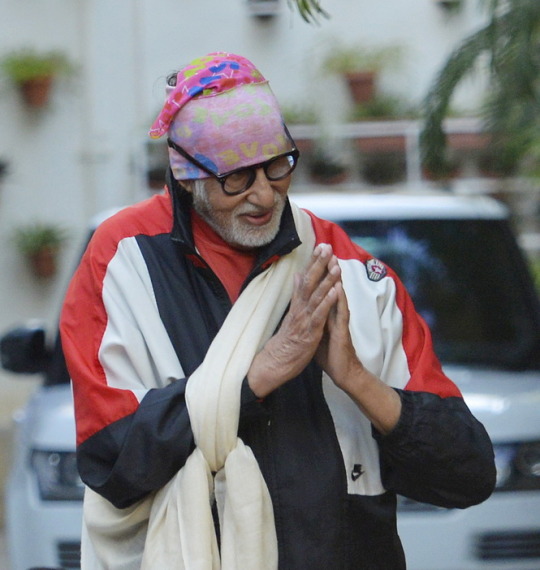





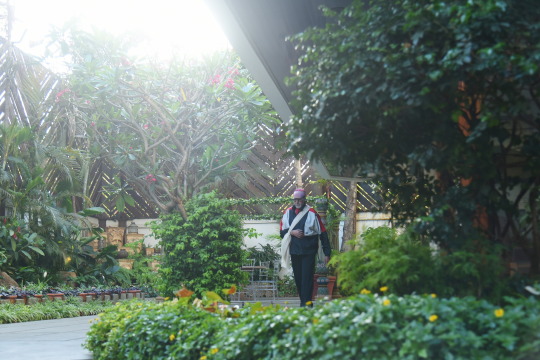
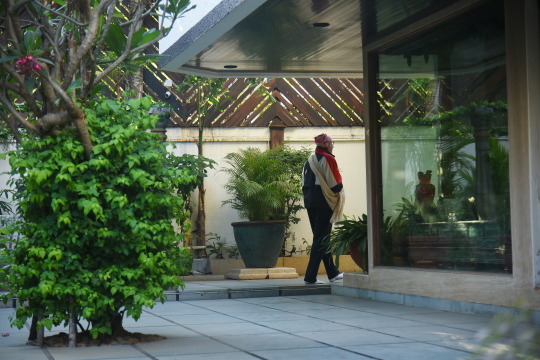


And the very revealing aspect for the coming day be that on April 3, for the first time an adventure took place .. the first plane to fly over the Everest .. in the year 1934 , apparently ..
Justification :
📌 .. and on this day .. April 3, 1933 .. conquering the impossible .. happened the first fly ever over Everest 🏔️ .. by two British aircraft of type Westland Wallace bi-planes .. crewed by Squadron Leader Douglas-Hamilton and Colonel LVS Blacker in one and Flight Lieutenant MacIntyre and Mr SR Bonnet in the other .. they took off from Lalbalu aerodrome, near Purnea, India .. the flight lasted for around three hours, covered a return distance of 320 miles reaching nearly 30,000 feet clearing the mountain by a reported 100 feet .. close range photographs of Mt Everest proved the achievement which previously was not possible to any airplane ..
further justification -






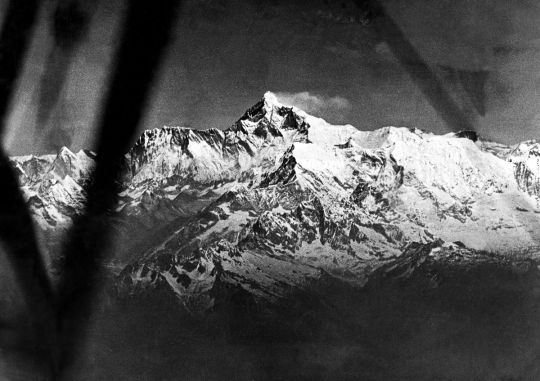
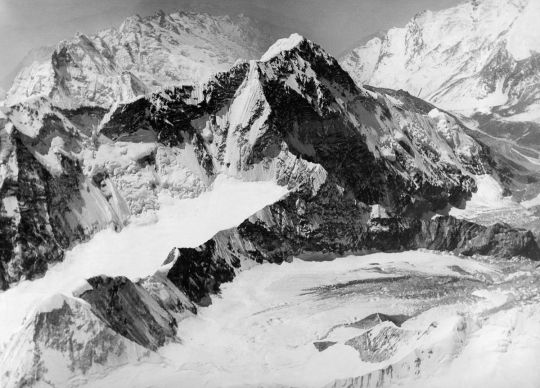





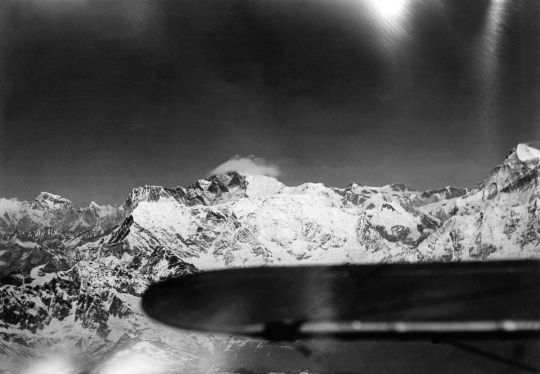


the peak , the highest point on Earth .. the mountain , the Himalayas and the feat that seems to this generation to be no big deal, because they are unaware of the conditions and circumstances that prevailed then ..
Everest .. named by the British when they ruled over India ..
In the nineteenth century, the mountain was named after George Everest, a former Surveyor General of India. The Tibetan name is Chomolungma, which means “Mother Goddess of the World.” The Nepali name is Sagarmatha, which has various meanings.
Sagarmatha .. ‘sagar’ , the Ocean .. ‘matha’ churning .. and the Indian mythology that the Oceans were churned by the mountain to produce the ‘amrit’ ..
my interpretation .. though the knowledge from the records says this :
Sagarmatha is a Sanskrit word, from sagar = "sky" (not to be confused with "sea/ocean") and matha = "forehead" or "head", and is the modern Nepali name for Mount Everest.
the Goddess of the Sky .. in Tibet it is addressed as
Therefore, the historic, local Tibetan name for Mount Everest is Chomolungma, also spelled Qomolangma, meaning "Goddess Mother of the World." Chomolungma is pronounced "CHOH-moh-LUHNG-m?." The Nepali name for Mount Everest is Sagarmatha, meaning "Godess of the Sky." Some refer to the entire massif of peaks as ...
and the many adventure stories on the Sagarmatha prevail ..
And the great thrill at the time of a shooting in Nepal, when I went on a plane that flew us right next to the Everest and the experience almost unreal ..
Such be the moments of remembrance ..
It was a touristy matter and many such flights I do believe operate from Kathmandu, Nepal for the pleasure of tourists .. even now ..
Its majesty has never reduced despite the conquering of it by several now .. and the very sight of which evokes so much wonder .. the wonder of the Gods .. the makers that introduced us to us all .. and the reason of its formation .. that the entire subcontinent now known as India was a part of the continent of Africa, at Egypt .. and many millions of years ago the entire subcontinent broke away from the mother board and shifted travelled over the Indian Ocean, to the Eastern sub continent and attached itself there .. the impact of the joining of the land mass being so great , it formed the realm, now known as the Himalayas !!
I do not have authenticity on this , but it does seem to be believed , historically and geographically .
and the day in recuperation and the meeting at the Gate , of the ever present well wisher ..
Amitabh Bachchan
and the signature above out of place , because the icon that opens the Desktop to search the sign is JUST not appearing ..
and this has been on several times before too ..
this model of the updated Mac, the Ventura is absurd and has created many problems ..
deliberately done to attract more when the changed model is brought out ?? marketing and manufacturing often does that .. the deliberation to access the mode of investing in the latest and doing away with the present ..
154 notes
·
View notes
Text

June 2011 KTM Kathmandu Nepal
This is the last photo I took in 2011 Kathmandu :)
2011 Last day in Kathmandu. This is what the city looks like on the way to the airport with my luggage loaded in the car prepared by my friend :)
The Kathmandu Photo Series, which has continued since 2021, is also over this time. Thank you all for enjoying it :) And from tomorrow, I am going to start uploading another version :) I hope you will continue to enjoy it :)
I made a slideshow of the photos taken during my visit to Lumbini in 2011 :) I have posted them on YouTube, so I hope you will enjoy them too :) Used in the video The audio uses what I recorded in the morning in Kathmandu :) Enjoy the sound too :) https://youtu.be/wpjIjFU4ABM
I hope everyone has a good day :) =
2011カトマンズでの最後に撮影した1枚です:)
2011カトマンズの最終日。友達の準備してくれた車に荷物を積み込んで、空港に向かう車中の中かの街の様子です:)
2021年から続いた、カトマンズの写真シリーズも、今回で終了です。皆様に楽しんでいただき、感謝いたします:)そして、明日からは、別バージョンのupを開始します:)引き続き、楽しんでいただけると幸いです:)
2011年のルンビニへの訪問を撮影した写真に関しては、スライドショーを製作しました:)YouTubeにて、公開しているので、こちらの方も、楽しんでいただけると幸いです:)動画で使われている音声は、カトマンズ市内の朝の様相を私が録音したものを使用しています:)音の方も楽しんでください:)https://youtu.be/wpjIjFU4ABM
では、皆様にとって、今日も良き1日でありますように:)=
気合・気愛で555!!!
アラキ:)
© KOJI ARAKI Art Works
Daily life and every small thing is the gate to the universe :)
#2011#June 2011#ktm#kathmandu#nepal#street photograph#street photography#sky#cloud#people#car#motorcycle#from inside the car#roadside tree#sidewalk#photographers on tumblr#b&w photography#black and white photography#original photography#photography#koji araki art works#PENTAX K10#SIGMA 15mm 2.8 EX Fisheye#Fisheye#SIGMA#PENTAX
33 notes
·
View notes
Text
Untitled Wednesday Library Series, Part 116
I am often seized by the fatal American need to appreciate the novella.
Normally the novella I’m appreciating is a sort of abstraction, you understand, but today it’s Saad Z. Hossain’s 2019 The Gurkha and the Lord of Tuesday. Proximally a Tor book (which really means MacMillan), but actually published by Tom Doherty Associates.
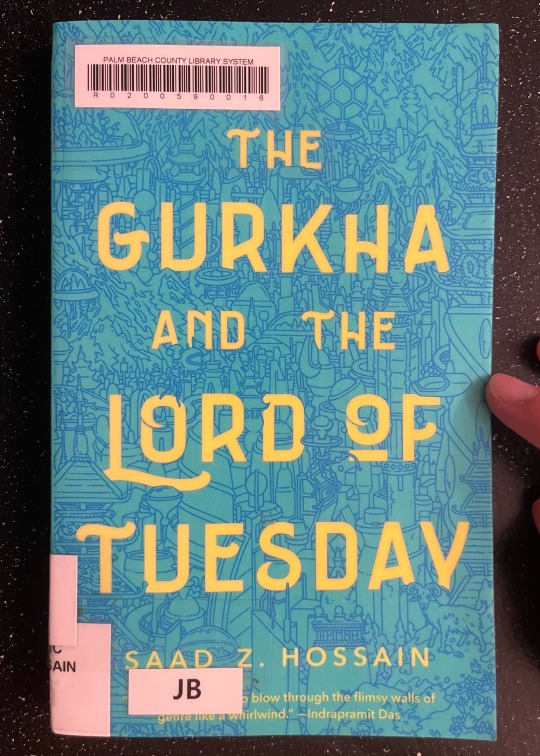
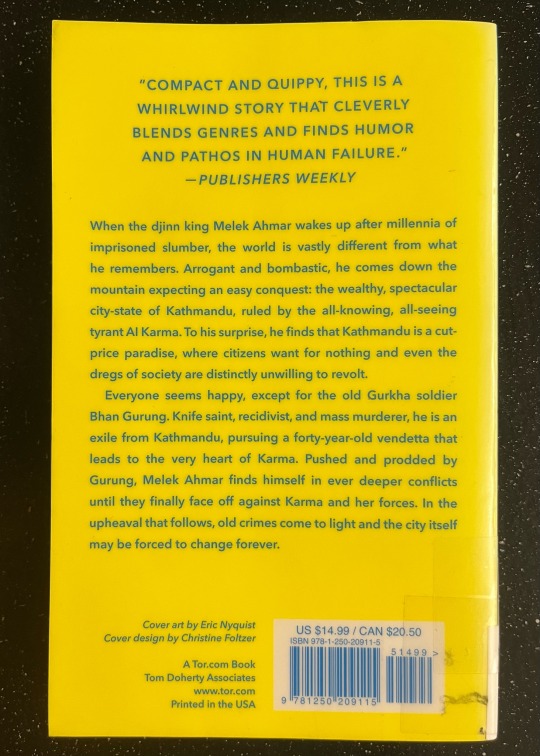

The How
Early last month, @girlfriendsofthegalaxy hit me with ‘I know you like a fucked up city/city-state’, which, yes, correct, I do. ‘Would you like an even more fucked up near-future city-state management system?’ In fact yes. After a quick poke around (drumroll) the internet, I managed to find this cheapish library discard. Ideal paragraph.
The Text
Quoth Kay, ‘Case cracked through improper records management. Very droll.’ Indeed.
Djinn, nanotech, a paradisical AI-controlled Kathmandu, the phrase ‘knife saint’, revenge of a somewhat political flavor, etc. Many reviews insist this is genre-bending or -blending as a selling point. I am made weary by such claims — surely much of modern sci-fi is within a couple degrees of this? — but whatever. It all works together more or less exactly like it seems to want to, which makes sense since this is not Hossain’s first time doing fun things with djinn. I’ve been away from this flavor of book for a while now, and I’m happy to return impressed.
This probably could have been distributed across twice as many pages, but I’m glad it wasn’t. The pace is what keeps the prose, premise, and setting working together, and if slower, the whole thing might grind itself flat.
The Object
Enthralled by whatever self-adhesive cover film the Palm Beach County Library System uses — I’ve handled a half dozen similar products and none of them beat this in clarity, neatness, rigidity, or sticking power. I want some.
Apart from the library film and stickers — tastefully registered, but there are too many (seven) of them — an unremarkable trade paperback. Fun cover art and design (credits Eric Nyquist and Christine Foltzer, respectively), but I can’t offer you any quips one way or the other about the type inside.
The Why, Though?
Kay bats a thousand. This is not a complicated equation.
17 notes
·
View notes
Text
one bizarre recurring event from my childhood is that every time my parents took me out on holiday, i would inexplicably take a photo of someone's funeral pyre. my folks had bought me a little film camera with no flash, and i was allowed a single roll of film. and every one of the five holidays i went on before i turned fifteen inevitably produced a very haunting, high contrast photo from a funeral pyre. that means, i've recorded funeral pyres in puri, digha, darjeeling, kathmandu, and sikkim. and one in bolpur also, but my aunt lives in bolpur so i don't think that counts as a holiday.
7 notes
·
View notes
Text

Summary
This project, led by an Indian NGO Mahila Housing Sewa Trust (MHT), is on a mission to organise and empower women in low-income households to increase their resilience to impacts of climate change. To date, MHT’s initiatives have helped 25,000 low-income families across seven cities in India, Bangladesh and Nepal.
The project is centred around an integrated model wherein women take the lead through collective action and technology incubation to devise locally relevant, pro‐poor, gender-sensitive and climate-resilient solutions. For example, women were trained to be energy auditors who encourage households to switch to more efficient products, forming a women-led distribution network of green energy and building products. Other solutions include using sprinkler taps to reduce the flow of water, harvesting rainwater, and other behavioural changes leading to more than 60% of households reporting to have increase in water quantity and more than 32% having sufficient water during summers.
Though projects like these, MHT is empowering women to take action against four major climate risks: heat waves, flooding and inundation, water scarcity, and water-vector-borne diseases. These slow‐onset events attract less attention but frequently impact poor people, particularly women, the most.
Key Facts
Mahila Housing Sewa Trust (MHT) has helped organise 114 Community Action Groups, who have reached out to 27,227 women in 107 slums. Of the women they’ve worked with, 8,165 women were recorded to demonstrate an increase in “knowledge seeking behavior”.
Over 1,500 women have been trained as climate-saathis, who are responsible for communicating the issue of climate change with their community in their local language. Through this communications exercise, the proportion of participants who viewed climate change as an act of god reduced from 26 % to 9 %.
To date, around 28,000 energy audits have been undertaken in slum communities, which have saved families over USD 700,000 per annum in electricity costs. These money and energy saving interventions have included installing over 200 modular roofs and 500 roofs with solar reflective white paint, while having also led to a reduction of 105 tonnes of CO2e per annum.
The Problem
It is estimated that over 190.7 million people live in informal settlements in South Asia. These settlements are often densely populated and highly vulnerable to even the slightest changes to our climate.
MHT’s project is building the resilience capacities of over 25,000 low-income families living in slums and informal settlements across seven cities in three South Asian countries, including: Ahmedabad, Bhopal, Ranchi, Jaipur, Bhubaneswar (India); Dhaka (Bangladesh), and Kathmandu (Nepal).
Their initiatives empower women to lead local mitigation efforts to prevent key climate risks such as heatwaves, flooding and inundation, and climate change related incidences of water-vector borne diseases. These types of slow-onset events tend to attract less global attention, while also disproportionately impacting low-income households. Women are commonly the primary caregiver and responsible for household management, which renders them more vulnerable to these types of stresses.
The Solution
MHT has championed a women-led empowerment model for building climate resilience in the slums of South Asia, focused around organising groups of women in their communities. Their model builds upon the conviction that if the urban poor are provided with requisite knowledge to undertake vulnerability and risk assessments, and are equipped with available resilient‐technologies, they will be able to devise and implement locally relevant and pro‐poor, climate-resilient solutions
The project model emphasizes women taking the lead through collective action and technology incubation in order to devise these locally relevant, gender-sensitive and climate-resilient solutions. To make this possible, MHT, assists with facilitating the required infrastructure, institutional and financial mechanisms.
Helping the Planet
Through empowering women, this project is also helping reduce the emissions associated with the production of electricity in these communities. For example, one of MHT’s core initiatives trains women to become energy auditors and educate households on the nuances of energy use such as bill calculation, wattage consumption and energy wastage. As energy auditors, these women also encourage households to switch to more energy efficient products.
These trained energy auditors also act as grassroots level micro-entrepreneurs, by forming a women-led distribution network of green energy and building products. Energy auditors promote the installation of energy efficient LED bulbs and lights, modular roofs, airlite ventilator, many other solutions.
Helping People
While women from low-income families are often the most vulnerable as they have the least access to information and resources, MHT believes they also have the greatest potential to be empowered to become agents of change.
The rationale for the project is to provide these women with the requisite knowledge to undertake vulnerability and risk assessments, while also equipping them with the available climate resilient-technologies. This means they will be able to identify climate induced vulnerabilities, minimize risk and adopt locally relevant climate resilient solutions. In turn, these women also can potentially play a role in influencing better city planning and governance for pro-poor adaptation and resilience actions.
Spillover Effect
Currently, MHT is in the process of training other grassroots organisations to reproduce similar women-led groups in areas such as Bhubaneswar, Dhaka and Kathmandu.
While many other urban resilience programs are top-down and externally driven, MHT has made a concerted effort to ensure their initiatives are low-cost, contextually-appropriate and participatory. Urban poor that have been organized under this program gather critical planning data to design their own solutions and negotiate with other urban stakeholders, as well as test and manage implementation of these solutions.
Through empowering women to help improve their homes and communities, MHT’s initiatives have also triggered behavior change in communities towards making more informed decisions. This has in turn empowered them with the necessary knowledge to demand improved government services, thus proving that this concept can be expanded to other communities throughout the world.
#mahila housing trust#mahila housing sewa trust#climate resilience#south asia#women led initiatives#climate change#inequality#sorry I couldn't get it to link properly so you get the whole thing#there's a video at the content source if you're interested
11 notes
·
View notes
Photo

Aaron Dilloway - Bhoot Ghar: Sounds Of The Kathmandu Horror House
Hanson Records
2023
8 notes
·
View notes
Text

Indian Rhinoceros
This one is by far the hardest illustration I have made on this blog. Pedro Jarque, a very well-known photographer, has an excellent photograph of the animal. The photograph has so many details that I didn't want to miss but it wasn't easy to translate. It took me forever to understand the skin of the rhino and because is my favorite animal, I wanted to look real nice.
Anyways, finishing up the African rhinos, we move to the Asian ones, and what better way to begin with than the Indian Rhinoceros.
It is the biggest of all the species of rhinos although some put the White rhinoceros in that place. They weren't easy to breed in captivity. The first recorded was in Kathmandu in 1826 and more than 100 years had to pass to have another born in captivity. There are zoo breeding programs in Europe and the USA that ensure the conservation of the species.
Its conservation status is vulnerable and is protected in all its habitat ranges. However, poaching still occurs.
Instagram
Store
______________________________
References:
Indian Rhinoceros
Photo Reference:
Pedro Jarque: Website | Instagram
___________________________________________
If you like the content, please give me a like and a follow. Every week one new animal.
#indian rhinoceros#rhino#rhinoceros#illustration#drawing#scientific illustration#illo#wild animals#wildlife#animals#mammals#artist on tumblr#animal#infographic#conservation#illustration scientifique#drawing animal#wild life
66 notes
·
View notes
Text
TIL that Daniel Vangarde (Bangalter) went from being banned on French radio to seeing his son win album of the year and more at the Grammys. He was there when Daft Punk won everything.
Now I got to go look at the Grammy footage and see if I can see him.
transcript of the Bilboard.com article:
Daniel Vangarde, Father Of Daft Punk’s Thomas Bangalter & Disco Innovator, Breaks His Silence
From his home in Brazil, the 75-year-old legend reflects on being banned from French radio, the best advice he gave to Daft Punk and the re-release of his catalog: "I think I will not die."
Daniel Vangarde has lived a fascinating life. He’s lived at least three of them, in fact.
His first act was as a producer, A&R and all-around catalyst for some of the most popular European disco and funk acts of the 1970s and ’80s, shifting millions of copies. Since the late 2000s he’s been residing and working in a Brazilian village of 750 people, teaching English, computer literacy, vocational skills and a range of artistic expression.
Somewhere in the middle he fathered a son, Thomas Bangalter, who also made some decent records himself.
Vangarde (born Bangalter) helped guide the early movements of Daft Punk, at a time when the pre-Homework duo had magic in their fingertips but hadn’t yet mastered the close control of image and narrative which forged their mystique. Vangarde doled out critical advice to Thomas, Guy-Manuel and a coterie of close friends in the ’90s Parisian scene, instilling in them the requisite knowledge to play the industry game on their own terms and better enabling them to sculpt their consequential destiny.
Then followed a high-profile battle with France’s publishing and rights society, SACEM, over both restrictive practices for modern artists and historical aberrations for post-World War II remuneration to Jewish musicians. Sufficiently content with both his own success and the imprint he left on the next generation, Vangarde retreated into silence, only fleetingly emerging when required (including a trip to the 2014 Grammy Awards, where he watched his son clean up). There were no plans to issue communiqués with the music ecosystem — until now.
Following a deal with powerhouse French label Because Music, the vaults of Vangarde’s Zagora Records have been busted open. The resultant compilation, Daniel Vanguarde: The Vaults of Zagora Records Mastermind (1971 - 1984), out Nov. 25 on Because Music, should re-situate him in a lineage of discotheque-pleasers with a taste for suave, symphonic and Star Wars-influenced material that bristles with joie de vivre. The comp is surprisingly tight for an era which left no excess untested; it’s not a stretch to say, from the colorway of his suit down to his perm, the Daniel Vangarde peering out from the cover might just have been the model for Disco Stu.
Having undertaken the grand sum of zero English-language interviews for 75 years, Vangarde made himself available to Billboard from the deep Bahian forests for an extremely rare and rather charming conversation about it all.
One thing that’s clear across your life is a fascination with culture and society outside of your own. You produced artists from the French Antilles and the West Indies, kickstarted a cossack dance craze in the late ’60s, and latterly founded an NGO. Where does this curiosity stem from?
I always liked traveling: I spent 10 summers of my adolescence in Costa Brava [Spain], visited Swinging London, and in 1966 hitchhiked from New York down to Mexico in order to visit the Tarahumara. Life felt like an adventure.
In 1971, I happened upon Guadeloupe and loved it — the people, the place, and the local rhythmic music, biguine, which I took back to work on in Paris. Throughout trips to Kathmandu, Bali and Malaysia in the ’70s, my love for African, Arabian, South American and other music outside the French or Anglo-Saxon tradition kept growing.
What were your dreams for the world back then?
Ah, that is easy. I was curious about the globe and completely against war. I was politically active from a young age. I was arrested during the student revolution in ’68 and spent three nights in a jail cell without light. That was very frightening. They say there were no deaths but I am certain this is untrue, there was great violence. For years afterward I had to cross the street whenever I saw a policeman, you know?
You had post-traumatic stress?
Yes, yes, it was this: it was post-traumatic stress. But I stayed against nuclear factories, against the Algerian War and successfully avoided my own military service. I did not change my point of view that mass consumption is a dead-end of civilization. In 1968, we had spiritual belief in a more open future. Today we have realism about our present moment, and that is what it is.
When you were 25, you and longtime collaborator Jean Kluger came up with Yamasuki, a faux-Japanese project whose only release is still pored over by record collectors and DJs like Four Tet. Why did you decide to jump into the deep end with such a specific concept?
Listen to this article
After the success of “Casatschok,” I was mostly considered a choreographer. Shows about kung fu were beginning to sweep through television, so Kluger and I thought about creating a Japanese dance, which we called Yamasuki, but the great sound of the music caught on more. We really got into a Japanese mindset: I bought an English-to-Japanese phrasebook, we learned phonetic pronunciation and taught a children’s choir lyrics in Japanese. We even hired a karate master to deliver a shout of death [kiai] — except he had no sense of rhythm, so I would stand in the studio, cueing him when to shout… and trembling on the other side of the mic.
As disco became popular globally, and you had French artists like Cerrone winning Grammy Awards for Best New Artist, was there any competition or jealousy? Or did you regard them as your peers?
Peers, totally. There was no competition at all. If there was any competition, in fact, it was with American and English production. I never used a mastering studio; I would be there at the Phillips factory, watching the acetate get pressed, making sure the sound was impeccable. Cerrone, he was not a friend, but we would see each other at the discotheques when taking our new records to the DJ for promotion. The same applies for Jacques Morali {the disco producer responsible for the Village People] — at this time, for the French to have success away from home was a great feeling.
Some of the records you worked on were massive. “D.I.S.C.O.” was the third biggest-seller of 1980 in Germany and the fifth in the UK; the Gibson Brothers sold millions of copies; you’ve been sampled and covered by Erykah Badu, Bananarama, Roger Sanchez — it’s a legacy of success by any other name. Did that come as a surprise to you?
I will say that when I started to make songs, I wanted to write to The Beatles and tell them that there should be five members. [Laughs] I was this certain that I could bring something to them. I imagine that maybe everybody that records hopes that his music will be understood and appreciated by the public. But even if I was expecting success, I recognize it’s a great privilege to live your life off of music.
What was your relationship to fame throughout all this?
I only did one LP as a frontman, which had the privilege of being banned on radio and television. The lyrics concerned how France is the third biggest producer of bombs and mines. Of course, that’s a state secret, so the record was buried, and I was never a frontman again. But that’s alright: I was an author, composer and producer; an artisan. I sought no fame, no show business. A reporter asked me recently: “So you live your life in the shadows?” And I said, “No! I live in the light, normally, like you do.”
Interest in the Zagora reissue is however fun to me, because I was not fashionable at all. I produced La Compagnie Créole, a very big band in the ’80s, and we could sell out three nights at L’Olympia but I could never once get a journalist to come see the show. That’s just how it was then. If it’s not chanson, it’s not serious. In France, popular music is suspicious.
By the time your career wound down around 1990, was the love for music still present? Was it a creative rupture or a decision to be with your family?
Truthfully, I was not producing music that excited me, and I thought it unwise to carry on. When making a hit my hands would become wet while mixing, and a physical sensation would overtake my belly. So if I was not feeling anything, why would anyone else? Also, there was a new generation doing dance music, and of course this was very close for me.
Yes, on that note… perhaps no one in the last 10 years has done more to kickstart the revival of disco and analog production than your son, Thomas. Why do you think that era has swept back into the public consciousness?
I can see why. Nothing replaces rhythm. Songs that you can dance to, with a melody you can sing — not rap, not techno, not even Daft Punk can compete with this human response to a good feeling. There are different chapels today: you have country radio, rap radio, rock radio, but the old repertoire has maintained.
What aggregates the masses are famous hits, and disco was the last of this kind of music. When they decided that disco was over and they started to burn the records [1979’s infamous bonfire of hate, Disco Demolition], I thought it was a joke, because I never thought happy, dancing music could possibly fade. And when disco came back, I realized it hadn’t faded after all.
Your know-how helped ground not only a young Daft Punk, but also their peers Phoenix and Air, all of whom credit your advice with allowing them to navigate the music biz and retain creative freedom.
I think all artists should have this freedom. I helped Thomas, Guy-Man and their friends as much as I could to allow them to release without barriers. They were only 20 years old and the industry could have squeezed them — a normal contract generates interference between your work and the time it’s released. I made an introduction to my English lawyer, who is still [Daft Punk’s] lawyer today, and advised them not to let the author’s rights society in France authorize their music for film or publicity. My input was to help create a good environment that allowed them to produce freely.
Do you think the industry is a better place for young artists now than it was in the ’90s, or the ’70s? Or is it contingent on who you are?
That’s difficult to say. I think the music industry is in a terrible situation, not because of the internet, but because record companies and publishers didn’t know how to use the internet. When I helped Thomas set up Daft Club [a groundbreaking hub for digital downloads and fan service, released in tandem with 2001’s Discovery] even then, many considered the internet science fiction for geeks. And what was the result?
They should have contracted the hackers! The best guy from Napster should have been contracted by record companies to organize a new paid system. At a time when people paid $10-20 for an LP, of course they would have accepted paying $1 instead. But the industry did nothing, music became like free air, and once the value collapsed to zero for many years, it was hard to come back from this.
In the ’70s, the artistic directors of a record company or programmers of a radio station held all the control. So I didn’t think it was good then. But I can’t say it’s better today either. It’s difficult for true talent to break through or generate wealth in the same fashion as before.
As you’ve never given interviews, your working practice from that era is lost. I mean — Bangalter now rings with a uniqueness and star quality, so why did you use Vangarde as your professional surname?
I wanted to allow future Thomas to use Bangalter! No, I chose a pen name in case I had success; I did not wish to book a hotel or restaurant and be recognized. Why Vangarde? Originally I had prepared Morane, the name of a small French plane in the early 1900s. But on the day of registration with SACEM, this was already taken, so I was given one minute to change. I quickly thought of another plane called the Vanguard, and this stuck by complete accident.
You’ve been distant from your own catalog for so long. Why now?
I’m afraid it’s not very romantic. I have known Emmanuel [de Buretel, kingpin of French electronic music] since he was 25. When Because Music showed interest in buying Zagora Records and releasing some old tracks, I trusted them, and said, “You’ll be the owner of the catalog, so if you want to, yes.” As I have never done photos or interviews, I did not expect interest at all. I could even not remember some of their choices, so I had to go on YouTube and listen back as I was certain these were not my songs! To see any reaction has been a huge shock. Because made a very good decision.
So you never considered what you’d like your legacy to be?
I think I will not die. I have songs that I did 50 years ago that are still popular. If people are happy when they hear the songs and go to dance, or go to see the bands still touring, they do not die. This is the answer of my legacy.
And are you satisfied?
Yes, I’m very happy. I have the privilege to do what I want, and a good personal life… in the shadows. [Laughs] I have a good relationship with Thomas and now I have two grandchildren. One is 20 years old and the other is 14 — I love them. I go on being free and having my health. What more can I ask for?
12 notes
·
View notes
Photo
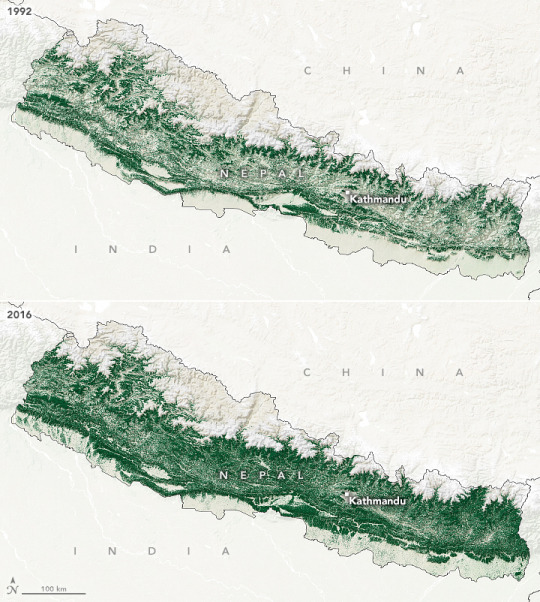

How Nepal Regenerated Its Forests In the 1970s, Nepal was facing an environmental crisis. Forests in Nepal’s hillsides were being degraded due to livestock grazing and fuelwood harvesting, which led to increased flooding and landslides. Without large-scale reforestation programs, a 1979 World Bank report warned, forests in the country’s hills would be largely gone by 1990. In the 1980s and 1990s, Nepal’s government began to reassess its national-level forest management practices, which led to a pivotal forestry act in 1993. This legislation allowed Nepal’s forest rangers to hand over national forests to community forest groups. The result of this community-led management, recent NASA-funded research has found, was a near-doubling of forest cover in the small mountainous country. The maps above show forest cover in Nepal in 1992 (top) and 2016 (bottom). Between these years, forest cover in the country almost doubled, from 26 percent to 45 percent. Using the long-term data record from Landsat satellites, along with in-depth interviews with people in Nepali villages, the research group found that community forest management was associated with the regrowth of forests. Most of the tree regrowth happened in middle-elevations, in the hills between the Himalayas and the plains of the Ganges River. “Once communities started actively managing the forests, they grew back mainly as a result of natural regeneration,” said Jefferson Fox, the principal investigator of the NASA Land Cover Land Use Change project and Deputy Director of Research at the East-West Center in Hawaii. Before Nepal passed the 1993 forestry act, government management of forests was less active. “People were still using the forests,” Fox added, “they just weren’t allowed to actively manage them, and there was no incentive to do so.” As a result, the forests were heavily grazed by livestock and picked over for firewood. They became degraded. Under community forest management, local forest rangers worked with the community groups to develop plans outlining how they could develop and manage the forests. People were able to extract resources from the forests (fruits, medicine, fodder) and sell forest products, but the groups often restricted grazing and tree cutting, and they limited fuelwood harvests. Community members also actively patrolled forests to ensure they were being protected. These maps show forest cover in Kābhrepalāñchok (Kabhre Palanchok) and Sindhupālchok (Sindhu Palchok), districts in the Bagmati Province east of Kathmandu. These districts were the focus of recent regional land cover change analysis because of their early adoption of community forestry. Beginning in the 1980s, the Australian government financed tree planting projects in these districts as well as the development of community forest groups. In many of the community forests, active management allowed trees to grow back naturally in the hills, but tree planting efforts were needed in lower elevation areas that were largely devoid of vegetation. One community forest (called Devithan or sacred grove in Nepali) lies to the east of Kābhrepalāñchok. Using Landsat data dating back to 1988, the research group found that the Devithan community forest had only 12 percent forest cover in 1988, which grew to 92 percent in 2016. Although the Devithan community forest wasn’t a formal community forest until 2000, the community organized into an informal community forest management group (with laws limiting grazing and fuelwood collecting) after the 1993 forestry act. The study found that trees and vegetation rapidly regenerated, expanding canopy cover and the availability of fodder within the first few years of informal management. Within the boundaries of this community forest, about 25 percent of total forest regeneration happened before Nepal’s forest rangers formally recognized them as a community group. Today, community forests occupy nearly 2.3 million hectares—about a third of Nepal’s forest cover—and are managed by over 22,000 community forest groups comprising 3 million households. A 2016 United Nations report on the state of forests around the world found that three countries with the most annual gain in tree cover between 2010 and 2015 were the Philippines (with an annual growth rate of 3.3 percent), Chile (1.8 percent), and Lao PDR (0.9 percent). Within community forests of Kābhrepalāñchok and Sindhupālchok, forest growth between 2010 and 2015 was 1.84 percent. NASA Earth Observatory images by Lauren Dauphin, using data from Van Den Hoek, J., et al. 2021. Story by Emily Cassidy.
9 notes
·
View notes
Audio
(Carlos Vivanco)
2 notes
·
View notes
Note
what’s were the careers of the different beatles girls? i know pattie was a model, jane was an actress, linda was a photographer, and yoko was an experimental artist, but what did the others do?
Maureen Cox
Used to be a hairdresser before she and Ringo married. I'm not aware of any job she did after that? She's said to have been very creative and artistic, but none of the things she made are available to the public. After divorcing Richie, she married Isaac Tigrett, co-founder of Hard Rock Café.
Fun fact: Apple 1, the first-ever pressing by Apple Records, was a private recording by Frank Sinatra, a birthday present for Mo.
Barbara Bach
She was famous for being a Bond girl before she met Ringo and also as a model during the sixties. Her IMDB filmography ends with To The North of Kathmandu, a 1986 short film. Give My Regards To Broad Street was one of the last films she ever acted in. I guess that killed the whole idea of movies for her.
Fun fact: Like Linda Eastman, she attended the Beatles' 1966 Shea Stadium concert.
Olivia Arias
George hired her from the marketing department of A&M Records to work for Dark Horse Records, and she was still working for Dark Horse after they got romantically involved. According to Giles Martin, George used to 'wake Olivia up in the middle of the night because he wanted to do an overdub and he had no one to press the record button,' so you could say she helped him make music, too.
Fun fact: After getting him away from The Rock Star Lifestyle™ in the seventies, fighting off the intruder in 1999 represented the second time that Olivia saved George's life.
Cynthia Powell
John and Cyn famously met during art college. Cyn was a bit more serious about her studies than John but still failed to get her art teacher's diploma. Around this time, she found out she was pregnant.
Fun Fact: She once owned a restaurant called Lennon's in Covent Garden. It had menu items such as Sgt. Pepper's Steak, Penny Lane Pâté, and Rubber Sole.
4 notes
·
View notes
Text

How Nepal Regenerated Its Forests
In the 1970s, Nepal was facing an environmental crisis. Forests in Nepal’s hillsides were being degraded due to livestock grazing and fuelwood harvesting, which led to increased flooding and landslides. Without large-scale reforestation programs, a 1979 World Bank report warned, forests in the country’s hills would be largely gone by 1990.
In the 1980s and 1990s, Nepal’s government began to reassess its national-level forest management practices, which led to a pivotal forestry act in 1993. This legislation allowed Nepal’s forest rangers to hand over national forests to community forest groups. The result of this community-led management, recent NASA-funded research has found, was a near-doubling of forest cover in the small mountainous country.
The maps above show forest cover in Nepal in 1992 (top) and 2016 (bottom). Between these years, forest cover in the country almost doubled, from 26 percent to 45 percent. Using the long-term data record from Landsat satellites, along with in-depth interviews with people in Nepali villages, the research group found that community forest management was associated with the regrowth of forests. Most of the tree regrowth happened in middle-elevations, in the hills between the Himalayas and the plains of the Ganges River.
“Once communities started actively managing the forests, they grew back mainly as a result of natural regeneration,” said Jefferson Fox, the principal investigator of the NASA Land Cover Land Use Change project and Deputy Director of Research at the East-West Center in Hawaii. Before Nepal passed the 1993 forestry act, government management of forests was less active. “People were still using the forests,” Fox added, “they just weren’t allowed to actively manage them, and there was no incentive to do so.” As a result, the forests were heavily grazed by livestock and picked over for firewood. They became degraded.
Under community forest management, local forest rangers worked with the community groups to develop plans outlining how they could develop and manage the forests. People were able to extract resources from the forests (fruits, medicine, fodder) and sell forest products, but the groups often restricted grazing and tree cutting, and they limited fuelwood harvests. Community members also actively patrolled forests to ensure they were being protected.
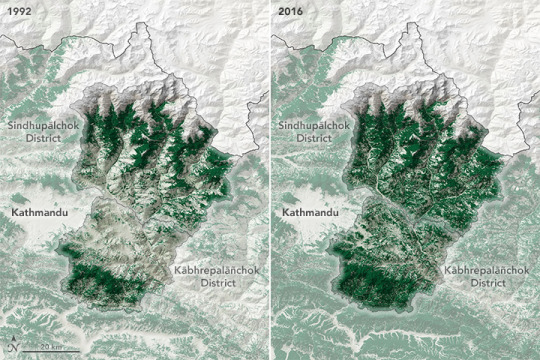
These maps show forest cover in Kābhrepalāñchok (Kabhre Palanchok) and Sindhupālchok (Sindhu Palchok), districts in the Bagmati Province east of Kathmandu. These districts were the focus of recent regional land cover change analysis because of their early adoption of community forestry. Beginning in the 1980s, the Australian government financed tree planting projects in these districts as well as the development of community forest groups. In many of the community forests, active management allowed trees to grow back naturally in the hills, but tree planting efforts were needed in lower elevation areas that were largely devoid of vegetation.
One community forest (called Devithan or sacred grove in Nepali) lies to the east of Kābhrepalāñchok. Using Landsat data dating back to 1988, the research group found that the Devithan community forest had only 12 percent forest cover in 1988, which grew to 92 percent in 2016.
Although the Devithan community forest wasn’t a formal community forest until 2000, the community organized into an informal community forest management group (with laws limiting grazing and fuelwood collecting) after the 1993 forestry act. The study found that trees and vegetation rapidly regenerated, expanding canopy cover and the availability of fodder within the first few years of informal management. Within the boundaries of this community forest, about 25 percent of total forest regeneration happened before Nepal’s forest rangers formally recognized them as a community group.
Today, community forests occupy nearly 2.3 million hectares—about a third of Nepal’s forest cover—and are managed by over 22,000 community forest groups comprising 3 million households. A 2016 United Nations report on the state of forests around the world found that three countries with the most annual gain in tree cover between 2010 and 2015 were the Philippines (with an annual growth rate of 3.3 percent), Chile (1.8 percent), and Lao PDR (0.9 percent). Within community forests of Kābhrepalāñchok and Sindhupālchok, forest growth between 2010 and 2015 was 1.84 percent.
NASA Earth Observatory images by Lauren Dauphin, using data from Van Den Hoek, J., et al. 2021. Story by Emily Cassidy.
8 notes
·
View notes
Text
Holidays 8.31
Holidays
Baloch-Pakhtun Unity Day
Cow Chip Tossing Day
Crop Dusting Day
Day of Solidarity and Freedom (Poland)
Festal Day (Order of the Eastern Star)
Flag Day (India)
Hari Kebangsaan (Malaysia)
International Blog Day (a.k.a. International Day of Blogs and Bloggers)
International Day for People of African Descent (UN)
International Overdose Awareness Day
Limba Noastra (Day of Our Language; Moldova)
Love Litigating Lawyers Day
Merdeka Day (Malaysia)
National Box Car Day
National Dan Day
National Diatomaceous Earth Day
National HalfCut Day (Australia)
National Leslie Day
National Matchmaker Day
National South Carolina Day
North Borneo Self-Government Day
National Zoo Awareness Day (UK)
Opioid Misuse Prevention Day
Overdose Awareness Day
Princess Diana Memorial Day
Rabbit Rabbit Day [Last Day of Every Month]
Romanian Language Day (Romania)
Sărbătoarea (a.k.a. Limba noastră; Language Day; Moldova)
Take a Seat Day
Tank Day (Lešany, Czech Republic)
Walnut Day (French Republic)
We Love Memoirs Day
White Rose Day (Australia)
Withdrawal of the Last American Soldier Anniversary Day (Afghanistan)
World Distance Learning Day
World Sanskrit Day
World Solidarity Day
Food & Drink Celebrations
Bacon Day [also 12.30]
Eat Outside Day
Grape Blessing Day (Armenia)
Invent A New Sandwich Day
National Trail Mix Day
Vegetable Day (Japan)
5th & Last Thursday in August
National Banana Pudding Day [Last Thursday]
National Cabernet Sauvignon Day [Last Thursday]
Thoughtful Thursday [Thursday of Be Kind to Humankind Week]
Independence Days
Befshire (Declared; 2016) [unrecognized]
Kyrgyzstan (from USSR, 1991)
Malaysia (from UK, 1957)
Trinidad and Tobago (from UK, 1962)
Feast Days
Aidan of Lindisfarne (Christian; Saint)
Alter Ego Day (Pastafarian)
Aristides of Athens (Christian; Saint)
Cuthburh (Christian; Saint)
Dominguito del Val (Christian; Saint)
Fourth Onam (Rice Harvest Festival, Day 4; Kerala, India)
Frey’s Blot (Pagan)
Gai Jatra (Cow Festival, in remembrance of people who died the previous year; Kathmandu Valley, Nepal)
Henry (Muppetism)
Isabel (Christian; Saint)
Joseph of Arimathea (Christian; Saint)
Jouffroy (Positivist; Saint)
Nicodemus (Christian; Saint)
Paulinus of Trier (Christian; Saint)
Paul Reubens Day (Church of the SubGenius; Saint)
Raymond Nonnatus (Christian; Saint)
Roger Dean (Artology)
Wala of Corbie (Christian; Saint)
Waltheof, Earl of Northumbria (Christian; Saint)
Lucky & Unlucky Days
Butsumetsu (仏滅 Japan) [Unlucky all day.]
Lucky Day (Philippines) [48 of 71]
Premieres
All Or Nothing At All, recorded by Frank Sinatra (Song; 1939)
American Idiot, by Green Day (Song; 2004)
Andor (TV Series; 2022)
Bad, by Michael Jackson (Album; 1987)
The Big Sleep (Film; 1946)
Bolero (Film; 1984)
Bugsy and Mugsy (WB LT Cartoon; 1957)
The Commuter, by Philip K. Dick (Short Story; 1953)
The Constant Gardener (Film; 2005)
Document, by R.E.M. (Album; 1987)
Fly, by Dixie Chicks (Album; 1999)
Foundation and Earth, by Isaac Asimov (Novel; 1986) [Foundation #5]
Get Rich Quick (Disney Cartoon; 1951)
Goat’s Head Soup, by The Rolling Stones (Album; 1973)
The Great Gildersleeve (Radio Series; 1941)
Jack Ryan (TV Series; 2018)
Only Murders in the Building (TV Series; 2021)
Orient Express, by Graham Greene (a.k.a. Stamboul Train; Novel; 1932)
Pluto’s Judgement Day (Disney Cartoon; 1935)
The Psychology of Intelligence, by Jean Piaget (Science Book; 1947)
Raising Demons, by Shirley Jackson (Memoir; 1957)
The Threepenny Opera, by Bertolt Brecht (Play with Music; 1928)
Wildest Dreams, by Taylor Swift (Song; 2015)
The World According to Garp, by John Irving (Novel; 1978)
Today’s Name Days
Paulinus, Raimubd (Austria)
Josip, Nikodem, Optat, Paulina (Croatia)
Pavlína (Czech Republic)
Bertha (Denmark)
Arved, Arvi, Arvid (Estonia)
Arvi (Finland)
Aristide (France)
Aidan, Anja, Paulinus, Raimund (Germany)
Bella, Erika (Hungary)
Aristide (Italy)
Aigars, Aira, Labite, Vilma (Latvia)
Raimunda, Raimundas, Vilmantas, Vilmantė (Lithuania)
Berta, Berte (Norway)
Bohdan, Paulina, Rajmund, Rajmunda, Świętosław (Poland)
Nora (Slovakia)
Ramón (Spain)
Arvid, Vidar (Sweden)
Aden, Aidan, Aiden, Ayden, Edan, Edana, Eden, Edina, Egan, Egon (USA)
Today is Also…
Day of Year: Day 243 of 2024; 122 days remaining in the year
ISO: Day 4 of week 35 of 2023
Celtic Tree Calendar: Coll (Hazel) [Day 24 of 28]
Chinese: Month 7 (Geng-Shen), Day 16 (Xin-You)
Chinese Year of the: Rabbit 4721 (until February 10, 2024)
Hebrew: 14 Elul 5783
Islamic: 14 Safar 1445
J Cal: 3 Aki; Threesday [3 of 30]
Julian: 18 August 2023
Moon: 99%: Waning Gibbous
Positivist: 19 Gutenberg (9th Month) [Jouffroy]
Runic Half Month: Rad (Motion) [Day 4 of 15]
Season: Summer (Day 71 of 94)
Zodiac: Virgo (Day 10 of 32)
2 notes
·
View notes
Text
Hot Weather
The far western city of Nepal saw record-breaking heat on June 9, 2023, with temperatures of about 46 degrees. In the non-tropical nation of Nepal, both winter and summer are experienced. Despite being located in a cold region shielded by the stunningly extended himalayas, Nepal's climate is currently suffering from a severe heat wave. In contrast, today's heat is so oppressive that even classes cannot be held in Nepal, where schools have never had to close because of the weather. Additionally, heat stroke has been linked to fatalities in some cases. Making history in this way.
The issue with the heat, though, is that it keeps rising. Nepal has three regions: Terai, Pahad, and Himal.
The lowest region of Nepal, known as Terai, is where the bulk of people—50 percent—live. Although Terai is meant to be hot, it has recently been hotter than tropical nations. Heat is primarily caused by deforestation.
Yes, it may sound strange or peculiar. It is true that people are harming plants to such an extent due to a lack of knowledge that even Google Maps shows that Terai has changed from a green area to a yellow area. The more CO2 (carbon dioxide) there are in an area, the more humidity there is, which leads to oppressive levels of heat. Government, like with other problems, is the issue here. The government donates and sells lands that are beneficial in exchange for money. According to Nepali culture, owning a home is something only rich people do, while renting an apartment is seen as a poor living situation. This viewpoint could also be a key factor. If current trends continue, the entire nation will become urbanized, making it potentially impractical to build even a road. In the capital city of Nepal, all that can be seen are houses, we can observe the effects of urbanization. Building houses has become such a fad in Kathmandu that people are doing it illegally by offering money or playing bluffs. The mayor has been acting, thank God.
Even God cannot save us if urbanization increased as rapidly as predicted. Millions or billions of plants that are vital to the ecology are wiped out by urbanization. The government continues to approve the construction of a brand-new airport, which would destroy millions of trees, wildlife, and other things. Why are we in need of more airports when we already have three? What if we put all of our attention on developing those airports? How can you expect a country to evolve or thrive if the government actively promotes such behavior?
I believe the government ought to provide a solution, such as by developing its own infrastructure that people might rent out. introducing initiatives such as "Planting Trees in Barren Land". Talk about the things that do in the legislature rather than buffaloes. Order every local authority to stop selling land and concentrate on creating a garden full of trees that could improve the nation and people's lives by extending life expectancy. There are several issues in Nepal that we can resolve by banding together in the same way that the Great Man Prithivi Narayan Shah united this lovely nation.
2 notes
·
View notes
Audio
Kundan Lal - Power of Ra
Gathering a cult following amongst people like Den Sorte Skole or DJ Marcelle with his previous releases, he is now set to sail new shores. There is a sense of wanderlust as he opens his box of field recordings, collected on his many travels. From the buzzing streets of Alexandria, early sunday markets in Tafraoute or a crackling bonfire down by the banks of the river Ganges. Each track takes you places.
Kundan's second album is a captivating blend of dubby beats, collages, and exotic instrumentation. Drawing from classic tools like the Roland 808, SC7 and the famous Space Echo, Kundan has created a unique and minimalistic sound that is sure to captivate listeners. At once nostalgic and experimental, "Power of Ra" is a must-listen for both electronic music purists and fans of adventurous soundscapes.
Compelled to work from home on his computer during lockdown, Kundan dusted his pawnshop e-piano, downloaded some orchestral soundkits and started to digitize almost forgotten field recordings. The "Power of Ra“ came to him.
It is hard to put your finger on his style or genre. You can feel Kundan Lal‘s DIY spirit in his production, carving his own ethnic genre. For enthusiasts of Roberto Musci or Muslimgauze, this avant-garde album is one for your collection. Keep your senses open and let the Power of Ra pass you to another world.
all field recordings made by Kunsaf Halil between 1999-2005 in:
unknown city, Egypt (1)+(6) * Marrakesh, Morocco (2) * Alexandria, Egypt (3)+(8) * Varanasi, India (4) * Hampi, India (5) * Tafraoute, Morocco (9)
sampled sound of Bedouin coffee grinder in Jordan desert recorded by Deben Bhattacharya (5)+(6)+(8) * word by Greta Thunberg (5) * voice cuts from the movie „Aas Paas“ (7)
front photographed by Tomas Berger in Kathmandu
artwork by Manekineko
2 notes
·
View notes